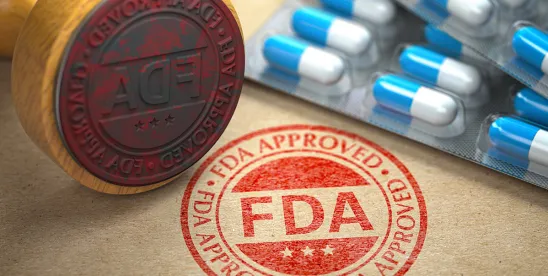On July 17, 2024—but just recently posted to the Office of Prescription Drug Promotion (OPDP) of the U.S. Food and Drug Administration (FDA) website—FDA issued its second untitled letter (letter) of the year to Kaleo, Inc. (Kaleo) over social media promotion of AUVI-Q® (epinephrine injection, USP). The social content was posted on the personal Instagram account of Brittany Mahomes—yes, that Mahomes. While the letter is splashy by virtue of its target and the message presented, the content, rationale, and findings by FDA are not surprising—linking to important safety information (ISI) alone is not enough, especially when the product is intended to treat a potentially life-threatening condition in children. FDA made a tough choice to go on the record against a message that looked like a public service announcement about recognizing anaphylaxis and talking to a doctor about your kids’ health.
Background
In the letter, FDA describes how the AUVI-Q FDA-approved labeling INDICATIONS AND USAGE section states that the product is indicated “in the emergency treatment of allergic reactions [] including anaphylaxis to stinging [and] biting insects, allergen immunotherapy, foods, drugs, diagnostic testing substances[,] and other allergens, as well as idiopathic anaphylaxis or exercise-induced anaphylaxis.” AUVI-Q is, moreover, “intended for immediate administration” in patients with increased anaphylactic risk, as well as those with a history of anaphylactic reactions. The section goes on to describe how these reactions occur, their hallmarks, and a reminder that AUVI-Q is intended for immediate self-administration as emergency supportive therapy but is not a substitute for immediate medical care.
FDA also describes—in just a few lines—the warnings and precautions of AUVI-Q, including injection-related complications, serious infections at the injection site, allergic reactions associated with sulfite, and disease interactions. Finally, FDA underscores that common adverse reactions to systemically administered epinephrine include anxiety, apprehensiveness, restlessness, tremor, weakness, dizziness, sweating, palpitations, pallor, nausea and vomiting, headache, and respiratory difficulties.
FDA Analysis
FDA’s core thesis for alleging that the social media post misbranded AUVI-Q centered on the failure to reveal any material facts about safety of the product commensurate with the presentation of information about the products benefits, which serves to provide context about the downsides (i.e., warnings, precautions, and side effects) that can result from using the product. The promotional materials are available on OPDP’s website and include both the Instagram post (i.e., the body text and acknowledgement of sponsorship), as well as the video embedded into the post. FDA focused on three simple statements from Mahomes:
- She has an infant and a toddler with severe food allergies but implying that a reaction “may not look how you think it should look”. And after talking to a doctor, she was prescribed AUVI-Q, “the only epinephrine autoinjector out there for infants and toddlers.” (SUPER, video portion of post)
- AUVI-Q “is for life-threatening allergic emergencies.” (SUPER, video portion of post)
- “[S]haring my experience with [my child’s] severe allergic reaction to peanuts . . . . partnering with @auvi_q to help spread awareness about severe food allergies in young children and how to best respond . . . . AUVI-q 0.1 mg is for infants and toddlers 16.5-33 lbs.” (text portion of post)
FDA acknowledged the total omission of risk information but did acknowledge that the post included the statement in the text portion that said, “For Important Safety Information, visit @auviq_ISI[.]” However, ISI linking was not enough for FDA to mitigate the “misleading impression created by the omission of risk information.”
Takeaways
FDA did not have to reach deep for inspiration in writing this letter—it is an old adage that you should not attempt to balance a claim (yes, including a mere statement of indication)—with a link to ISI. Admittedly, FDA regulations on fair balance are not entirely clear, but the best practice is and always has been to add some safety information, even if it is a quick quip about the top warnings and/or precautions, or a brief recitation of the top common adverse events. And of course, if there is a contraindication in play, then that should probably be added, at a minimum.
Social media presents an added layer of complexity in that messages are comprised of post text and accompanying media—pictorial or video, the latter can have supers and on-screen textual disclaimers—that needs to be analyzed separately and as a combination because what might count as “balance” on one part may not satisfy the standard overall. FDA was intentional about outlining—in two short sentences—the warnings, precautions, and common adverse reactions in the latter. Had this been added to the text portion of the post, Kaleo likely does not get this letter.
This might be the most cited rationale for these letters—omission of safety information. Among other things, FDA’s mandate in regulating drug promotion is to protect public health by ensuring that consumers know how to use a drug appropriately and know what to look out for in the event of a side effect or adverse reaction. FDA stuck to that mandate here. But let’s steelman for Kaleo—wasn’t Kaleo (via Mahomes) trying to do the right thing by using a parent’s real-life experience, leveraging a wide social platform, to get the word out about the severity of anaphylactic reactions, including how not all reactions look the same? Is it not the physician’s responsibility to walk through the safety details with the parents before making a prescribing decision? Kaleo did put a link to the ISI in the post text, and the post itself was not packed full of benefit claims about the product—just some basic information about the product, the approved patient population, etc.
Unlike other omission of safety information letters where the fruit is hanging pretty low for FDA, FDA likely ruminated on this one a bit before issuing, determining that the potential harm outweighed the potential good. And so it goes—when in doubt, sprinkle a little more safety information.



 />i
/>i

